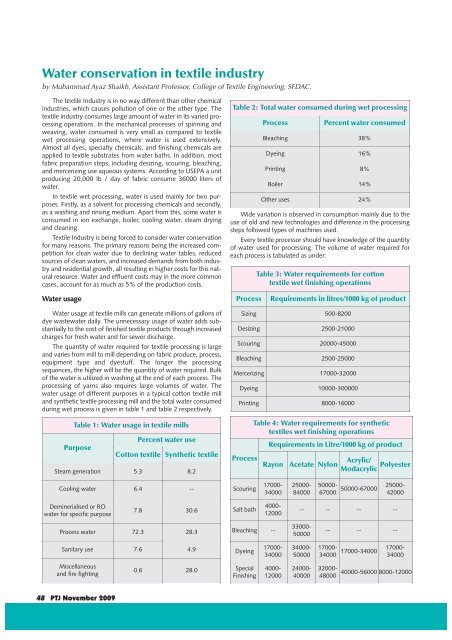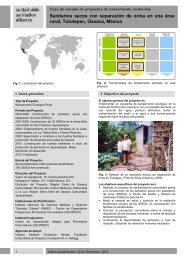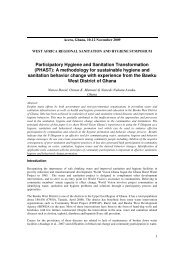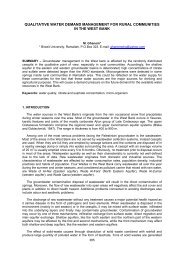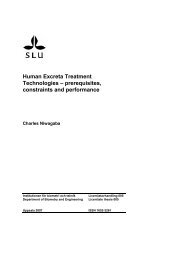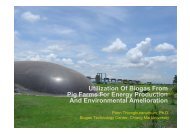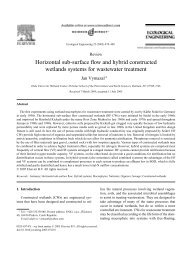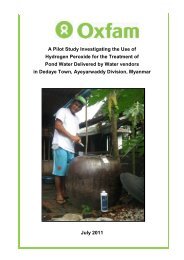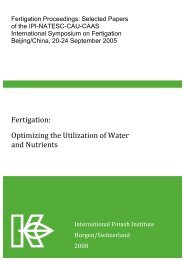Water conservation in textile industry - SSWM
Water conservation in textile industry - SSWM
Water conservation in textile industry - SSWM
You also want an ePaper? Increase the reach of your titles
YUMPU automatically turns print PDFs into web optimized ePapers that Google loves.
<strong>Water</strong> <strong>conservation</strong> <strong>in</strong> <strong>textile</strong> <strong>in</strong>dustry<br />
by Muhammad Ayaz Shaikh, Assistant Professor, College of Textile Eng<strong>in</strong>eer<strong>in</strong>g, SFDAC.<br />
The <strong>textile</strong> Industry is <strong>in</strong> no way different than other chemical<br />
<strong>in</strong>dustries, which causes pollution of one or the other type. The<br />
<strong>textile</strong> <strong>in</strong>dustry consumes large amount of water <strong>in</strong> its varied process<strong>in</strong>g<br />
operations. In the mechanical processes of sp<strong>in</strong>n<strong>in</strong>g and<br />
weav<strong>in</strong>g, water consumed is very small as compared to <strong>textile</strong><br />
wet process<strong>in</strong>g operations, where water is used extensively.<br />
Almost all dyes, specialty chemicals, and f<strong>in</strong>ish<strong>in</strong>g chemicals are<br />
applied to <strong>textile</strong> substrates from water baths. In addition, most<br />
fabric preparation steps, <strong>in</strong>clud<strong>in</strong>g desiz<strong>in</strong>g, scour<strong>in</strong>g, bleach<strong>in</strong>g,<br />
and merceriz<strong>in</strong>g use aqueous systems. Accord<strong>in</strong>g to USEPA a unit<br />
produc<strong>in</strong>g 20,000 Ib / day of fabric consume 36000 liters of<br />
water.<br />
In <strong>textile</strong> wet process<strong>in</strong>g, water is used ma<strong>in</strong>ly for two purposes.<br />
Firstly, as a solvent for process<strong>in</strong>g chemicals and secondly,<br />
as a wash<strong>in</strong>g and r<strong>in</strong>s<strong>in</strong>g medium. Apart from this, some water is<br />
consumed <strong>in</strong> ion exchange, boiler, cool<strong>in</strong>g water, steam dry<strong>in</strong>g<br />
and clean<strong>in</strong>g.<br />
Textile Industry is be<strong>in</strong>g forced to consider water <strong>conservation</strong><br />
for many reasons. The primary reasons be<strong>in</strong>g the <strong>in</strong>creased competition<br />
for clean water due to decl<strong>in</strong><strong>in</strong>g water tables, reduced<br />
sources of clean waters, and <strong>in</strong>creased demands from both <strong>in</strong>dustry<br />
and residential growth, all result<strong>in</strong>g <strong>in</strong> higher costs for this natural<br />
resource. <strong>Water</strong> and effluent costs may <strong>in</strong> the more common<br />
cases, account for as much as 5% of the production costs.<br />
<strong>Water</strong> usage<br />
<strong>Water</strong> usage at <strong>textile</strong> mills can generate millions of gallons of<br />
dye wastewater daily. The unnecessary usage of water adds substantially<br />
to the cost of f<strong>in</strong>ished <strong>textile</strong> products through <strong>in</strong>creased<br />
charges for fresh water and for sewer discharge.<br />
The quantity of water required for <strong>textile</strong> process<strong>in</strong>g is large<br />
and varies from mill to mill depend<strong>in</strong>g on fabric produce, process,<br />
equipment type and dyestuff. The longer the process<strong>in</strong>g<br />
sequences, the higher will be the quantity of water required. Bulk<br />
of the water is utilized <strong>in</strong> wash<strong>in</strong>g at the end of each process. The<br />
process<strong>in</strong>g of yarns also requires large volumes of water. The<br />
water usage of different purposes <strong>in</strong> a typical cotton <strong>textile</strong> mill<br />
and synthetic <strong>textile</strong> process<strong>in</strong>g mill and the total water consumed<br />
dur<strong>in</strong>g wet process is given <strong>in</strong> table 1 and table 2 respectively.<br />
Table 1: <strong>Water</strong> usage <strong>in</strong> <strong>textile</strong> mills<br />
Purpose<br />
48 PTJ November 2009<br />
Percent water use<br />
Cotton <strong>textile</strong> Synthetic <strong>textile</strong><br />
Steam generation 5.3 8.2<br />
Cool<strong>in</strong>g water 6.4 --<br />
Dem<strong>in</strong>erialised or RO<br />
water for specific purpose<br />
7.8 30.6<br />
Process water 72.3 28.3<br />
Sanitary use 7.6 4.9<br />
Miscellaneous<br />
and fire fight<strong>in</strong>g<br />
0.6 28.0<br />
Table 2: Total water consumed dur<strong>in</strong>g wet process<strong>in</strong>g<br />
Process Percent water consumed<br />
Bleach<strong>in</strong>g 38%<br />
Dye<strong>in</strong>g 16%<br />
Pr<strong>in</strong>t<strong>in</strong>g 8%<br />
Boiler 14%<br />
Other uses 24%<br />
Wide variation is observed <strong>in</strong> consumption ma<strong>in</strong>ly due to the<br />
use of old and new technologies and difference <strong>in</strong> the process<strong>in</strong>g<br />
steps followed types of mach<strong>in</strong>es used.<br />
Every <strong>textile</strong> processor should have knowledge of the quantity<br />
of water used for process<strong>in</strong>g. The volume of water required for<br />
each process is tabulated as under:<br />
Table 3: <strong>Water</strong> requirements for cotton<br />
<strong>textile</strong> wet f<strong>in</strong>ish<strong>in</strong>g operations<br />
Process Requirements <strong>in</strong> litres/1000 kg of product<br />
Siz<strong>in</strong>g 500-8200<br />
Desiz<strong>in</strong>g 2500-21000<br />
Scour<strong>in</strong>g 20000-45000<br />
Bleach<strong>in</strong>g 2500-25000<br />
Merceriz<strong>in</strong>g 17000-32000<br />
Dye<strong>in</strong>g 10000-300000<br />
Pr<strong>in</strong>t<strong>in</strong>g 8000-16000<br />
Process<br />
Scour<strong>in</strong>g<br />
Salt bath<br />
Table 4: <strong>Water</strong> requirements for synthetic<br />
<strong>textile</strong>s wet f<strong>in</strong>ish<strong>in</strong>g operations<br />
Requirements <strong>in</strong> Litre/1000 kg of product<br />
Rayon Acetate Nylon Acrylic/<br />
Modacrylic Polyester<br />
17000-<br />
34000<br />
4000-<br />
12000<br />
Bleach<strong>in</strong>g --<br />
Dye<strong>in</strong>g<br />
Special<br />
F<strong>in</strong>ish<strong>in</strong>g<br />
17000-<br />
34000<br />
4000-<br />
12000<br />
25000-<br />
84000<br />
50000-<br />
67000 50000-67000<br />
25000-<br />
42000<br />
-- -- -- --<br />
33000-<br />
50000<br />
34000-<br />
50000<br />
24000-<br />
40000<br />
-- -- --<br />
17000-<br />
34000 17000-34000<br />
32000-<br />
48000<br />
17000-<br />
34000<br />
40000-56000 8000-12000
Top view wash<strong>in</strong>g tank<br />
Wash<strong>in</strong>g efficiency<br />
Wash<strong>in</strong>g process is characterized by its wash<strong>in</strong>g efficiency<br />
that is the amount of the compound that is removed divided by<br />
the total amount that could have been removed. Wash<strong>in</strong>g efficiency<br />
is not directly dependent on the amount of water used but<br />
is a function of:<br />
Temperature<br />
Speed of fabric <strong>in</strong> the wash<strong>in</strong>g range<br />
The properties of the fabric<br />
The properties of the wash<strong>in</strong>g range<br />
Temperature<br />
Textile<br />
<strong>Water</strong><br />
The temperature is important <strong>in</strong> wash<strong>in</strong>g because the temperature<br />
<strong>in</strong>fluences;<br />
a. The viscosity of water. At a lower viscosity water can better<br />
penetrate through the fabric and wash<strong>in</strong>g will become more<br />
effective.<br />
b. The aff<strong>in</strong>ity of compounds. At a higher temperature the aff<strong>in</strong>ity<br />
decreases and results <strong>in</strong> a better wash<strong>in</strong>g away of the<br />
unwanted components.<br />
c. Migration of the components from the <strong>in</strong>ner fibre to the<br />
water around the fiber. This migration is important for the<br />
total time the wash<strong>in</strong>g process will take.<br />
Speed of fabric <strong>in</strong> the wash<strong>in</strong>g range<br />
The speed of fabric <strong>in</strong> the wash<strong>in</strong>g range determ<strong>in</strong>es the<br />
amount of water that is hanged <strong>in</strong> the fabric by pass<strong>in</strong>g a roller <strong>in</strong><br />
the wash<strong>in</strong>g compartment. That is the liquor that was <strong>in</strong> the fabric<br />
before pass<strong>in</strong>g the roller with a high concentration of the<br />
unwanted components that is replaced by the wash<strong>in</strong>g liquor<br />
with a low concentration of the unwanted components.<br />
The properties of the fabric<br />
Figure 1 Scheme of a wash<strong>in</strong>g tank.<br />
The properties of fabric <strong>in</strong>fluence the wash<strong>in</strong>g effectiveness<br />
by the amount of water that can be pressed through the fabric<br />
dur<strong>in</strong>g wash<strong>in</strong>g. The openness of the fabric as well as the openness<br />
of yarn determ<strong>in</strong>es the length of the way the unwanted<br />
component has to migrate to the fluid that can be exchanged <strong>in</strong><br />
the wash<strong>in</strong>g process. In the wash<strong>in</strong>g process generally only very<br />
little water from the pores between the fibres is exchanged when<br />
the yarns are strongly twisted this will be practically zero. As<br />
migration is a very slow process it will take much longer for all the<br />
components to be washed out. The same holds more or less for<br />
thicker yarns and heavy weight fabrics.<br />
The properties of the wash<strong>in</strong>g range<br />
Side-view wash<strong>in</strong>g tank<br />
The effectiveness of the wash<strong>in</strong>g range is determ<strong>in</strong>ed by the<br />
number of wash<strong>in</strong>g tanks, the number of compartments <strong>in</strong> each<br />
tank, the diameter of the roller and the way the fabric is led through<br />
the wash<strong>in</strong>g range. The wash<strong>in</strong>g effectiveness can be improved by<br />
plac<strong>in</strong>g rollers on top of the top-rollers. This squeeze off the excess<br />
water <strong>in</strong> the fabric and a better exchange of wash<strong>in</strong>g liquid will be<br />
realized. Also at high speed these top rollers will prevent water to be<br />
taken with the fabric to the next compartment.<br />
<strong>Water</strong> <strong>conservation</strong> and reuse<br />
<strong>Water</strong> is expensive to buy, treat, and dispose. If the <strong>in</strong>dustry does<br />
not have water <strong>conservation</strong> program, its pour<strong>in</strong>g money downs the<br />
dra<strong>in</strong>. Now, water <strong>conservation</strong> and reuse are rapidly becom<strong>in</strong>g a<br />
necessity for <strong>textile</strong> <strong>in</strong>dustry. <strong>Water</strong> <strong>conservation</strong> and reuse can have<br />
tremendous benefits through decreased costs of purchased water and<br />
reduces costs for treatment of wastewaters. Prevention of discharge<br />
violations as a result of overload systems can be a significant <strong>in</strong>ducement<br />
for water <strong>conservation</strong> and reuse. By implement<strong>in</strong>g water <strong>conservation</strong><br />
and reuse programs, the decision to expand the treatment<br />
facilities can be placed on hold, and the available funds can then be<br />
used for expansion or improvements to process equipment.<br />
The first step <strong>in</strong> develop<strong>in</strong>g a water <strong>conservation</strong> and reuse<br />
program is to conduct a site survey to determ<strong>in</strong>e where and how<br />
water be<strong>in</strong>g used. It would be extremely helpful to develop a<br />
spreadsheet and/ or diagram of the water usage with specific<br />
details as shown below:<br />
Location and quantity of water usage.<br />
Temperature requirements.<br />
<strong>Water</strong> quality requirements, i.e. pH, hardness and limitations<br />
on solid content, must meet clean water standards, etc.<br />
Any special process requirements.<br />
<strong>Water</strong> <strong>conservation</strong> measures<br />
<strong>Water</strong> <strong>conservation</strong> measures lead to:<br />
Reduction <strong>in</strong> process<strong>in</strong>g cost.<br />
Reduction <strong>in</strong> wastewater treatment cost.<br />
Reduction <strong>in</strong> thermal energy consumption.<br />
Reduction <strong>in</strong> electrical energy consumption.<br />
Reduction <strong>in</strong> pollutants load.<br />
<strong>Water</strong> <strong>conservation</strong> significantly reduces effluent volume. A<br />
water <strong>conservation</strong> program can cut water consumption by up to<br />
30 percent or more, and the cost sav<strong>in</strong>gs can pay for the required<br />
materials <strong>in</strong> a very short time. S<strong>in</strong>ce the average plant has a large<br />
number of washers, the sav<strong>in</strong>gs can add up to thousands of<br />
rupees per year. Other reasons for large effluent volume is the<br />
choice of <strong>in</strong>efficient wash<strong>in</strong>g equipment, excessively long wash<strong>in</strong>g<br />
circles and use of fresh water at all po<strong>in</strong>ts of water use.<br />
The equipment used <strong>in</strong> a water <strong>conservation</strong> program is relatively<br />
<strong>in</strong>expensive, consist<strong>in</strong>g <strong>in</strong> most cases of valves, pip<strong>in</strong>g, small<br />
pumps, and tanks only. The operat<strong>in</strong>g costs for these systems are<br />
generally very low. Rout<strong>in</strong>e ma<strong>in</strong>tenance and, <strong>in</strong> some cases, electricity<br />
for the pumps, would be the major cost components.<br />
The payback period for a water <strong>conservation</strong> system will vary<br />
with the quantity of water saved, sewer fees, and costs for raw<br />
water and wastewater treatment. In addition to the direct cost sav<strong>in</strong>gs,<br />
a water <strong>conservation</strong> program can reduce the capital costs of<br />
any required end-of-pipe wastewater treatment system. Personnel<br />
from <strong>textile</strong> <strong>in</strong>dustry need to be aware of water <strong>conservation</strong> potential<br />
so they can help their organization realize the benefits.<br />
<strong>Water</strong> <strong>conservation</strong> methods for <strong>textile</strong> mills<br />
Numerous methods have been developed to conserve water<br />
at <strong>textile</strong> mills. Some of the techniques applicable to a wide variety<br />
of mills are discussed.<br />
Good Housekeep<strong>in</strong>g<br />
A reduction <strong>in</strong> water use of 10 to 30 percent can be accomplished<br />
by tak<strong>in</strong>g strict house keep<strong>in</strong>g measures. A walk through<br />
audit can uncover water waste <strong>in</strong> the form of:<br />
Hoses left runn<strong>in</strong>g.<br />
PTJ November 2009 49
Broken or miss<strong>in</strong>g valves.<br />
Excessive water use <strong>in</strong> wash<strong>in</strong>g operations.<br />
Leaks from pipes, valves, and pumps.<br />
Cool<strong>in</strong>g water or wash boxes left runn<strong>in</strong>g when mach<strong>in</strong>ery is<br />
shut down.<br />
Defective toilets and water coolers.<br />
Good house keep<strong>in</strong>g measures often carried out without significant<br />
<strong>in</strong>vestments, but lead<strong>in</strong>g to substantial cost sav<strong>in</strong>gs and<br />
the sav<strong>in</strong>g of water, chemicals and energy. Good house keep<strong>in</strong>g<br />
measures are essential for a company, which is critical about its<br />
own behaviors. Implement<strong>in</strong>g the follow<strong>in</strong>g can make significant<br />
reductions <strong>in</strong> water use<br />
M<strong>in</strong>imiz<strong>in</strong>g leaks and spills.<br />
Plugg<strong>in</strong>g leakages and checks on runn<strong>in</strong>g taps.<br />
Installation of water meters or level controllers on major<br />
water carry<strong>in</strong>g l<strong>in</strong>es.<br />
Turn off water when mach<strong>in</strong>es are not operat<strong>in</strong>g.<br />
Identify<strong>in</strong>g unnecessary wash<strong>in</strong>g of both fabric and equipment.<br />
Tra<strong>in</strong><strong>in</strong>g employees on the importance of water <strong>conservation</strong>.<br />
<strong>Water</strong> reuse<br />
<strong>Water</strong> reuse measures reduce hydraulic load<strong>in</strong>gs to treatment<br />
systems by us<strong>in</strong>g the same water <strong>in</strong> more than one process.<br />
<strong>Water</strong> reuse result<strong>in</strong>g from advanced wastewater treatment<br />
(recycle) is not considered an <strong>in</strong>-plant control, because it does not<br />
reduce hydraulic or pollutant load<strong>in</strong>gs on the treatment plant.<br />
Reuse of certa<strong>in</strong> process water elsewhere <strong>in</strong> mill operations<br />
and reuse of uncontam<strong>in</strong>ated cool<strong>in</strong>g water <strong>in</strong> operations requir<strong>in</strong>g<br />
hot water result <strong>in</strong> significant wastewater discharge reductions.<br />
Examples of process water reuse <strong>in</strong>clude:<br />
1. Reuse of water jet weav<strong>in</strong>g wastewater<br />
The jet weav<strong>in</strong>g wastewater can be reused with<strong>in</strong> the jet<br />
looms. Alternatively, it can be reused <strong>in</strong> the desiz<strong>in</strong>g or scour<strong>in</strong>g<br />
process, provided that <strong>in</strong>-l<strong>in</strong>e filters remove fabric impurities and<br />
oils.<br />
2. Reuse of bleach bath<br />
Cotton and cotton blend preparation are performed us<strong>in</strong>g<br />
cont<strong>in</strong>uous or batch processes and usually are the largest water<br />
consumers <strong>in</strong> a mill. Cont<strong>in</strong>uous processes are much easier to<br />
adapt to wastewater recycl<strong>in</strong>g/reuse because the waste stream is<br />
cont<strong>in</strong>uous, shows fairly constant characteristics, and usually is<br />
easy to segregate from other waste streams.<br />
Waste stream reuse <strong>in</strong> a typical bleach unit for<br />
polyester/cotton blend and 100 percent cotton fabrics would<br />
<strong>in</strong>clude recycl<strong>in</strong>g j-box and kier dra<strong>in</strong> waste water to saturators,<br />
recycl<strong>in</strong>g cont<strong>in</strong>uous scour wash water to batch scour<strong>in</strong>g, recycl<strong>in</strong>g<br />
washer water to equipment and facility clean<strong>in</strong>g, reus<strong>in</strong>g<br />
scour r<strong>in</strong>ses for desiz<strong>in</strong>g, reus<strong>in</strong>g mercerizes wash<br />
water or bleach wash water for scour<strong>in</strong>g.<br />
Preparation chemicals, however, must be selected<br />
<strong>in</strong> such a way that reuse does not create quality<br />
problems such as spott<strong>in</strong>g.<br />
Batch scour<strong>in</strong>g and bleach<strong>in</strong>g are less easy to<br />
Fabric <strong>in</strong><br />
adapt to recycl<strong>in</strong>g of waste streams because streams<br />
occur <strong>in</strong>termittently and are not easily segregated.<br />
With appropriate hold<strong>in</strong>g tanks, however, bleach<br />
bath reuse can be practiced <strong>in</strong> a similar manner to<br />
dye bath reuse and several pieces of equipment are<br />
now available that has necessary hold<strong>in</strong>g tanks.<br />
50 PTJ November 2009<br />
3. Reuse of f<strong>in</strong>al r<strong>in</strong>se water from dye<strong>in</strong>g for<br />
dye bath make-up<br />
The r<strong>in</strong>se water from the f<strong>in</strong>al r<strong>in</strong>se <strong>in</strong> a batch dye<strong>in</strong>g operation<br />
is fairly clean and can be used directly for further r<strong>in</strong>s<strong>in</strong>g or to<br />
make up subsequent dye baths. Several woven fabric and carpet<br />
mills use this r<strong>in</strong>se water for dye bath make-up.<br />
4. Reuse of soaper wastewater<br />
The coloured wastewater from the soap<strong>in</strong>g operation can be<br />
reused at the back grey washer, which does not require water of<br />
a very high quality. Alternatively, the wastewater can be used for<br />
clean<strong>in</strong>g floors and equipment <strong>in</strong> the pr<strong>in</strong>t and color shop.<br />
5. Reuse of dye liquors<br />
The feasibility of dye liquor reuse depends on the dye used<br />
and the shade required on the fabric or yarn as well as the type of<br />
process <strong>in</strong>volved. It has already been applied whilst disperse<br />
dye<strong>in</strong>g polyester, reactive dye<strong>in</strong>g cotton, acid dye<strong>in</strong>g nylon and<br />
basic dye<strong>in</strong>g acrylic, on a wide variety of mach<strong>in</strong>es. However,<br />
commission dye<strong>in</strong>g where the shades required are much more<br />
varied and unpredictable would make the reuse of dye liquor difficult.<br />
But, given the right conditions dye liquor could be reused<br />
up to 10 times before the level of impurities limits further use.<br />
6. Reuse of cool<strong>in</strong>g water<br />
Cool<strong>in</strong>g water that does not come <strong>in</strong> contact with fabric or<br />
process chemicals can be collected and reused directly. Examples<br />
<strong>in</strong>clude condenser-cool<strong>in</strong>g water, water from water-cooled bear<strong>in</strong>gs,<br />
heat-exchanger water, and water recovered from cool<strong>in</strong>g<br />
rolls, yarn dryers, pressure dye<strong>in</strong>g mach<strong>in</strong>es, and air compressors.<br />
This water can be pumped to hot water storage tanks for reuse <strong>in</strong><br />
operations such as dye<strong>in</strong>g, bleach<strong>in</strong>g, r<strong>in</strong>s<strong>in</strong>g and clean<strong>in</strong>g where<br />
heated water is required or used as feed<strong>in</strong>g water for a boiler.<br />
7. Reus<strong>in</strong>g wash water<br />
The most popular and successful strategy applied for reus<strong>in</strong>g wash<br />
water is counter-current wash<strong>in</strong>g.<br />
The counter-current wash<strong>in</strong>g method is relatively straightforward<br />
and <strong>in</strong>expensive. For both water and energy sav<strong>in</strong>gs, counter-current<br />
wash<strong>in</strong>g is employed frequently on cont<strong>in</strong>uous preparation and dye<br />
ranges. Clean water enters at the f<strong>in</strong>al wash box and flows counter to<br />
the movement of the fabric through the wash boxes. With this<br />
method the least contam<strong>in</strong>ated water from the f<strong>in</strong>al wash is reused for<br />
the next-to-last wash and so on until the water reaches the first wash<br />
stage, where it is f<strong>in</strong>ally discharged. Direct counter-current wash<strong>in</strong>g is<br />
now generally built <strong>in</strong>to the process flow sheet of new <strong>textile</strong> mills. It is<br />
also easy to implement <strong>in</strong> exist<strong>in</strong>g mills where there is a synchronous<br />
process<strong>in</strong>g operation.<br />
To dra<strong>in</strong><br />
Fresh water<br />
Wash Wash Soap Soap<br />
Hot<br />
wash<br />
To dra<strong>in</strong><br />
Hot<br />
wash<br />
Cold<br />
wash<br />
Fresh water<br />
Fabric out<br />
Figure 2 Recommended Counter-Current Flow of Wash<strong>in</strong>g on a Soaper Range.
Use of automatic shut-off valves<br />
An automatic shut-off valve set to time, level, or temperature<br />
controls the flow of water <strong>in</strong>to a process unit. One plant estimated<br />
that a reduction <strong>in</strong> water use of up to 20 percent could be<br />
achieved with thermally controlled shut-off valves.<br />
Use of flow control valves<br />
A flow or pressure-reduction valve can significantly reduce<br />
the quantity of water used <strong>in</strong> a wash or clean-up step. These<br />
valves are particularly useful <strong>in</strong> clean<strong>in</strong>g areas where operators are<br />
not always aware of the need for water <strong>conservation</strong>.<br />
Flocculation of clean water of pigment pr<strong>in</strong>t<strong>in</strong>g<br />
A rotary screen pr<strong>in</strong>ter uses as much water as a cont<strong>in</strong>uous<br />
wash<strong>in</strong>g range. All this water is used to wash the belt, to r<strong>in</strong>se the<br />
pipes and pumps and to clean the screens and squeegees. The<br />
water does not come <strong>in</strong> contact with the fabric. When only pigments<br />
are used for pr<strong>in</strong>t<strong>in</strong>g, it is relatively easy to coagulate the<br />
pigments and let them settle. The result is the clean water, which<br />
can be used for clean<strong>in</strong>g purposes.<br />
Use s<strong>in</strong>gle stage of process<strong>in</strong>g<br />
Knitted fabric process comb<strong>in</strong>ed bleach<strong>in</strong>g/scour<strong>in</strong>g and<br />
dye<strong>in</strong>g giv<strong>in</strong>g considerable sav<strong>in</strong>g <strong>in</strong> water. The scour<strong>in</strong>g and<br />
bleach<strong>in</strong>g process takes place for 10-20 m<strong>in</strong>utes and without<br />
dra<strong>in</strong><strong>in</strong>g the bath the dye<strong>in</strong>g is carried out without any loss of<br />
depth of colour value. In some cases the f<strong>in</strong>ish<strong>in</strong>g process can also<br />
be carried out along with the dye<strong>in</strong>g process.<br />
Use of low material to liquor ratio systems<br />
Different types of dye<strong>in</strong>g mach<strong>in</strong>ery use different amounts of<br />
water. Low liquor ratio dye<strong>in</strong>g mach<strong>in</strong>es conserve water as well as<br />
chemicals and also achieve higher fixation efficiency but the<br />
wash<strong>in</strong>g efficiency of some types of low liquor ratio dye<strong>in</strong>g<br />
mach<strong>in</strong>es, such as jigs, is <strong>in</strong>herently poor; therefore, a correlation<br />
between liquor ratio and total water use is not always exact.<br />
Typical liquor ratios for various types of dye<strong>in</strong>g mach<strong>in</strong>es are<br />
given below:<br />
Table-5: Liquor ratio <strong>in</strong> different dye<strong>in</strong>g mach<strong>in</strong>es<br />
Dye<strong>in</strong>g<br />
mach<strong>in</strong>e<br />
Typical liquor ratio liquor/goods<br />
at time of dye application<br />
Cont<strong>in</strong>uous 1:1<br />
W<strong>in</strong>ch 15:1-40:1<br />
Jet 7:1-15:1<br />
Jig 5:1<br />
Beam 10:1<br />
Package 10:1<br />
Beck 17:1<br />
Stock 12:1<br />
Ske<strong>in</strong> 17:1<br />
<strong>Water</strong> <strong>conservation</strong> measures <strong>in</strong> dye<strong>in</strong>g equipment<br />
Wash<strong>in</strong>g and r<strong>in</strong>s<strong>in</strong>g are both important for reduc<strong>in</strong>g impurity<br />
levels <strong>in</strong> the fabric to pre-determ<strong>in</strong>ed levels. <strong>Water</strong> and wastewater<br />
treatment prices are <strong>in</strong>creas<strong>in</strong>g, the optimization of water<br />
use pays dividends. One possible option is to reduce r<strong>in</strong>se water<br />
use for lighter shades. Here are some successful water reduction<br />
projects <strong>in</strong> batch and cont<strong>in</strong>uous operations.<br />
W<strong>in</strong>ch Dye<strong>in</strong>g: Dropp<strong>in</strong>g the dye bath and avoid<strong>in</strong>g overflow<br />
r<strong>in</strong>s<strong>in</strong>g could reduce water consumption reduced by 25%.<br />
High and Low: Replac<strong>in</strong>g the overflow with Pressure jet<br />
dye<strong>in</strong>g batch wise r<strong>in</strong>s<strong>in</strong>g can cut water consumption by approximately<br />
50%.<br />
Beam Dye<strong>in</strong>g: About 60% of water prevent<strong>in</strong>g overflows<br />
dur<strong>in</strong>g soak<strong>in</strong>g and r<strong>in</strong>s<strong>in</strong>g may reduce consumption. Automatic<br />
controls proved to be quite economical with a payback period of<br />
about four months.<br />
Jig Dye<strong>in</strong>g: A wide range of reductions rang<strong>in</strong>g from 15% to<br />
79% is possible by switch<strong>in</strong>g from the practice of overflow to<br />
stepwise r<strong>in</strong>s<strong>in</strong>g. R<strong>in</strong>s<strong>in</strong>g us<strong>in</strong>g a spray technique is also effective.<br />
Cheese Dye<strong>in</strong>g: A reduction of around 70% is possible follow<strong>in</strong>g<br />
<strong>in</strong>termittent r<strong>in</strong>s<strong>in</strong>g.<br />
Cont<strong>in</strong>uous Operation: A 20%-30% sav<strong>in</strong>g was realized by<br />
<strong>in</strong>troduc<strong>in</strong>g automatic water stops. Counter-current wash<strong>in</strong>g<br />
proved to be the most effective method. Horizontal wash<strong>in</strong>g<br />
equipment delivered the same performance as two vertical wash<strong>in</strong>g<br />
mach<strong>in</strong>es, us<strong>in</strong>g the same amount of water.<br />
References<br />
1. Bergenthal, J.F. “Wastewater recycle and reuse potential for<br />
<strong>in</strong>direct discharge <strong>textile</strong> f<strong>in</strong>ish<strong>in</strong>g mills”: Volume 1-Technical<br />
Report. U.S. Environmental Protection Agency.<br />
2. Waste reduction fact sheet, “<strong>Water</strong> <strong>conservation</strong> for <strong>textile</strong><br />
mills <strong>in</strong>dustrial pollution prevention program”. May 1993,<br />
NC division of pollution prevention and environmental assistance.<br />
3. NIIR Board, The complete technology book on “Textile process<strong>in</strong>g<br />
with effluents treatment”, Asia pacific bus<strong>in</strong>ess press<br />
Inc. I.S.B.N: 81-7833-050-4.<br />
4. Dr. Brent Smith, James Rucker, “<strong>Water</strong> and <strong>textile</strong> wet process<strong>in</strong>g,<br />
Part 1”, NCSU, Raleigh, NC.<br />
5. Edward Menezes, “Development <strong>in</strong> water treatment methods”,<br />
Pakistan Textile Journal, September 2003.<br />
6. Brown & Caldwell, “Industrial water <strong>conservation</strong> references<br />
of <strong>textile</strong> manufacturers and dyers”, California department of<br />
water resources.<br />
7. Environmental pollution control: “Textile process<strong>in</strong>g <strong>in</strong>dustry”,<br />
C<strong>in</strong>c<strong>in</strong>nati, OH: U.S. Environmental Protection Agency.<br />
8. Anton Luiken, Janet Mens<strong>in</strong>k, Lecture at the APTPMA sem<strong>in</strong>ar<br />
on “Environmental aspects of <strong>textile</strong> wet process<strong>in</strong>g”,<br />
2000.<br />
9. Jeffery D. Denit, Anne M. Gorsuch, Richard E. Williams,<br />
“Effluent limitations guidel<strong>in</strong>es and standards for the <strong>textile</strong><br />
mills po<strong>in</strong>t source category”, U.S. Environmental Protection<br />
Agency Wash<strong>in</strong>gton, D.C.<br />
10. Manual, “Better environmental management practices <strong>in</strong><br />
<strong>textile</strong> process<strong>in</strong>g sector”, World Wide Fund for Nature-<br />
Pakistan (WWF-P).<br />
11. Report 5, “Waste m<strong>in</strong>imisation and best practice”, The British<br />
Textile Technology Group, Ref: S5471, November 1999.<br />
12. Ms. Ilse Hendrickx, Gregory D. Boardman, “Pollution prevention<br />
studies <strong>in</strong> the <strong>textile</strong> Wet process<strong>in</strong>g <strong>in</strong>dustry”, 1995. Department<br />
of environmental quality office of pollution prevention.<br />
PTJ November 2009 51


